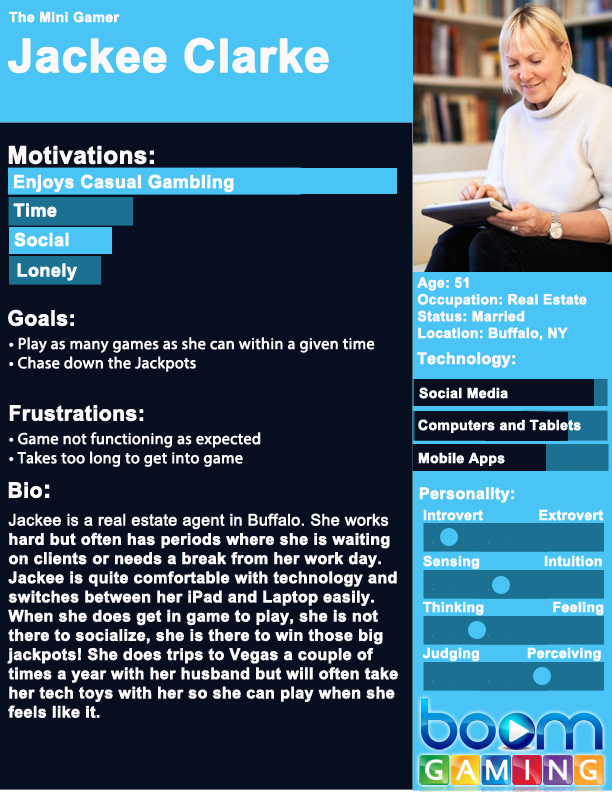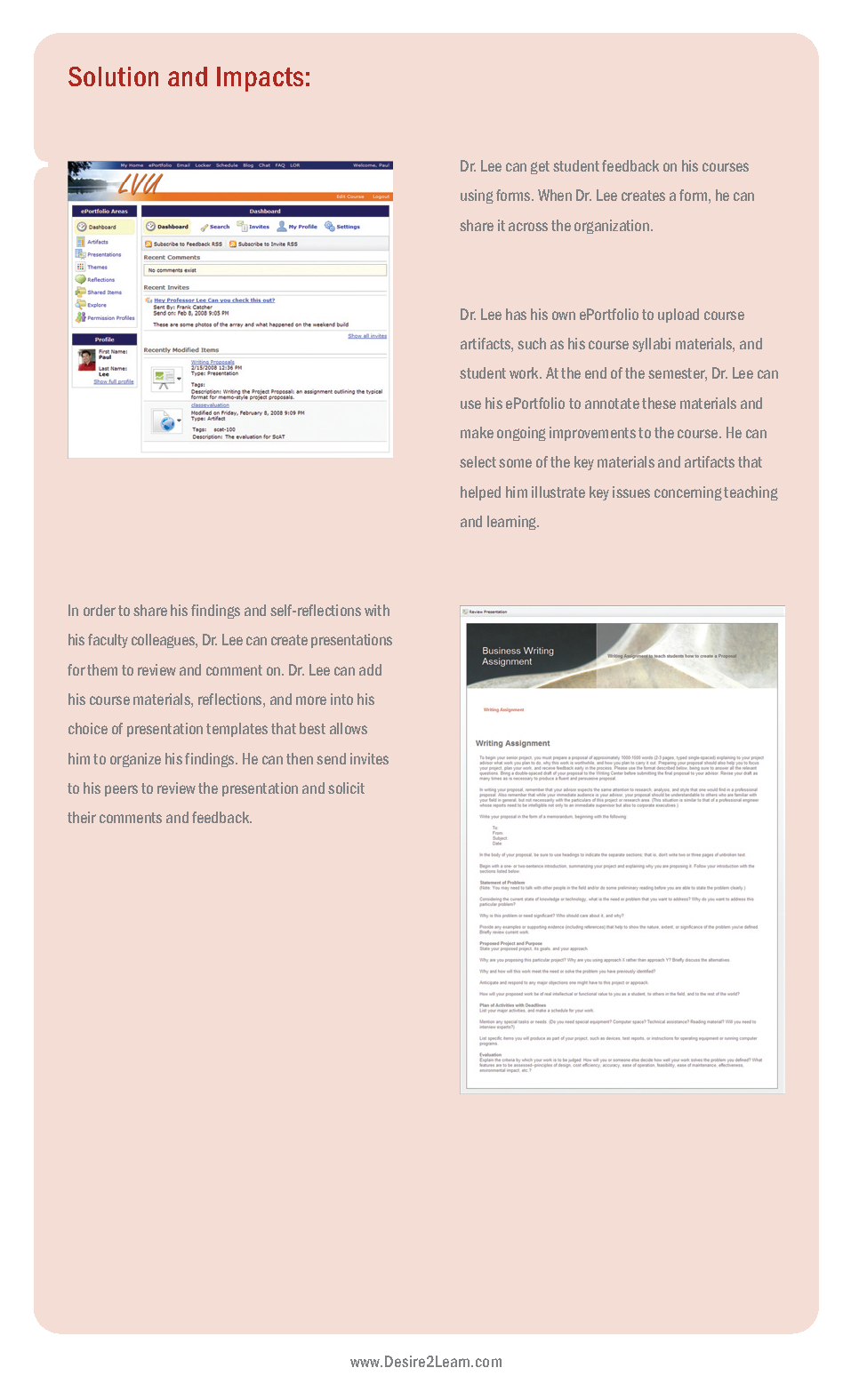
Boom Gaming Bingo Games (Character, Beach, Boom, and Dog) Persona:
The Problem: Boom Developers did NOT relate to the clients we build games for. Many development decisions were being made based on the preferences of the Developers, many of which are yoiung (20-25) and gamers. Without a clear understanding of who they are developing for, it became increasingly clear that we needed Persona's. We needed to understand how our bingo users play games, their motivations and their fears.
The Journey: Initilally I interviewed project participants and stakeholders to assess all current assumptions about our users. These people included Devs, the CTO and the CEO of Boom Gaming.
I then created a segment of the "types of users" in our market space and set up interviews with approx 3-5 people in each segment. I ended up speaking with 19 people within our assumed user types at Retirement Communities, Bingo Halls, and Casino's. Each "interview" consisted of some questions, a demonstration, and observation of them interracting with our software.
Durring each interview, I took extensive and exhaustive notes about answers to questions, reactions, what they did and how they did things.
From each interview, I put together my findings onto separate cards for sorting. I sorted the cards into common observations and gave each group of common observations a group title. I then repeated the card sorting activites with in each group to establish any sub group common themes.
Solution: Based on this, I built the primary persona for Boom Gaming Bingo Games (shown above). I then added some details to the persona to make it is little more personal and crafted a template for our Personas.

Primary Boom Gaming Casino Games (Pull Tab, Scratch, Slots, Wheel) Persona:
The Problem: Boom Developers do NOT relate to the clients we build games for. Many development decisions were being made based on the preferences of the Developers, many of which are yoiung (20-25) and gamers. Without a clear understanding of who they are developing for, it became increasingly clear that we needed Persona's. We needed to understand how our users play games, their motivations and their fears.
The Journey: Initilally I interviewed project participants and stakeholders to assess all current assumptions about our users. These people included Devs, the CTO and the CEO of Boom Gaming.
I then created a segment of the "types of users" in our Casino market space and set up interviews with approx 3-5 people in each segment. I ended up speaking with 19 people within our assumed user types at Retirement Communities and Casino's. Each "interview" consisted of some questions, a demonstration, and observation of them interracting with our software.
The Journey: Initilally I interviewed project participants and stakeholders to assess all current assumptions about our users. These people included Devs, the CTO and the CEO of Boom Gaming.
I then created a segment of the "types of users" in our Casino market space and set up interviews with approx 3-5 people in each segment. I ended up speaking with 19 people within our assumed user types at Retirement Communities and Casino's. Each "interview" consisted of some questions, a demonstration, and observation of them interracting with our software.
Durring each interview, I took extensive and exhaustive notes about answers to questions, reactions, what they did and how they did things.
From each interview, I put together my findings onto separate cards for sorting. I sorted the cards into common observations and gave each group of common observations a group title. I then repeated the card sorting activites with in each group to establish any sub group common themes.
From each interview, I put together my findings onto separate cards for sorting. I sorted the cards into common observations and gave each group of common observations a group title. I then repeated the card sorting activites with in each group to establish any sub group common themes.
Solution: Based on this, I built the primary persona for Boom Gaming Bingo Games (shown above). I then added some details to the persona to make it is little more personal and used our existing template for our Personas.

Primary Corporate ePortfolio Persona/Use Case (Desire2Learn) Page 1/4:
The Problem: Desire2Learn was still in its infancy with regards to UX. They had one UX Designer for the entire company and her primary focus was on developing a Pattern Design Library. Desire2Learn did not make use of Personas at all. Design was done by Developers and UI Deisgners who had very little understanding outside of assumption about the user base. ePortfolio was a relatively new concept for both Desire2Learn and the North American market share. As the concept was relatively new, I offered to create some Personas to assist the Developers and UI Deisgners in creating a better User Experience for ePortfolio by giving them a clearer understanding of their audience.
The Journey: I interviewed the ePortfolio Development team which consisted of Developers, Designers, Project Managers, the existing UX Designer, and the VP of Product Development (also my boss). This interview/meeting was to document all existing assumtions about ePortfolio, the users we were developing for and the purpose of the product.
I met with the VP of Product Development and a section of the Marketing team to get a clear market segment of the users D2L ePortfolio was aimed at. With the UX Designer, we set up interviews with approx 5-7 people in each segment for a total of about 27 users.
Each interview involved a question and answer session where all the users answers were documented. The second part of the interview was a demonstration of the ePortfolio. We answered and documented questions. We then observed as users navigated the ePortfolio as well as recorded each interview so we could monitor details like eye movement and keyboard and mouse activites.
From the interviews, we documented findings onto separate sorting cards. We sorted the cards into common observations. I found we had to repeat the card sorting activities few times to determine the sub-groups and even sub-sub-groups within.
Solution: Based on our findings, I built the 5 personas for Desire2Learn ePortfolio (shown above and continued below). I added details to each persona to make them a little more personal. These personas resulted in many design and development changes. The ePortfolio Development team hung these personas in the Quads for reference as they were dicussing new features or fixes and how these changes would impact Frank or Danielle...
The Problem: Desire2Learn was still in its infancy with regards to UX. They had one UX Designer for the entire company and her primary focus was on developing a Pattern Design Library. Desire2Learn did not make use of Personas at all. Design was done by Developers and UI Deisgners who had very little understanding outside of assumption about the user base. ePortfolio was a relatively new concept for both Desire2Learn and the North American market share. As the concept was relatively new, I offered to create some Personas to assist the Developers and UI Deisgners in creating a better User Experience for ePortfolio by giving them a clearer understanding of their audience.
The Journey: I interviewed the ePortfolio Development team which consisted of Developers, Designers, Project Managers, the existing UX Designer, and the VP of Product Development (also my boss). This interview/meeting was to document all existing assumtions about ePortfolio, the users we were developing for and the purpose of the product.
I met with the VP of Product Development and a section of the Marketing team to get a clear market segment of the users D2L ePortfolio was aimed at. With the UX Designer, we set up interviews with approx 5-7 people in each segment for a total of about 27 users.
Each interview involved a question and answer session where all the users answers were documented. The second part of the interview was a demonstration of the ePortfolio. We answered and documented questions. We then observed as users navigated the ePortfolio as well as recorded each interview so we could monitor details like eye movement and keyboard and mouse activites.
From the interviews, we documented findings onto separate sorting cards. We sorted the cards into common observations. I found we had to repeat the card sorting activities few times to determine the sub-groups and even sub-sub-groups within.
Solution: Based on our findings, I built the 5 personas for Desire2Learn ePortfolio (shown above and continued below). I added details to each persona to make them a little more personal. These personas resulted in many design and development changes. The ePortfolio Development team hung these personas in the Quads for reference as they were dicussing new features or fixes and how these changes would impact Frank or Danielle...

Primary Corporate ePortfolio Persona/Use Case (Desire2Learn) Page 2/4

Primary Corporate ePortfolio Persona/Use Case (Desire2Learn) Page 3/4

Primary Corporate ePortfolio Persona/Use Case (Desire2Learn) Page 4/4

Primary Higher Ed ePortfolio Persona/Use Case (Desire2Learn) Page 1/4

Primary Higher Ed ePortfolio Persona/Use Case (Desire2Learn) Page 2/4

Primary Higher Ed ePortfolio Persona/Use Case (Desire2Learn) Page 3/4

Primary Higher Ed ePortfolio Persona/Use Case (Desire2Learn) Page 4/4

Primary Higher Ed Administration ePortfolio Persona/Use Case (Desire2Learn) Page 1/4

Primary Higher Ed Administration ePortfolio Persona/Use Case (Desire2Learn) Page 2/4

Primary Higher Ed Administration ePortfolio Persona/Use Case (Desire2Learn) Page 3/4

Primary Higher Ed Administration ePortfolio Persona/Use Case (Desire2Learn) Page 4/4

Primary K-12 ePortfolio Persona/Use Case (Desire2Learn) Page 1/4

Primary K-12 ePortfolio Persona/Use Case (Desire2Learn) Page 2/4

Primary K-12 ePortfolio Persona/Use Case (Desire2Learn) Page 3/4

Primary K-12 ePortfolio Persona/Use Case (Desire2Learn) Page 4/4

Primary Instructors ePortfolio Persona/Use Case (Desire2Learn) Page 1/4

Primary Instructors ePortfolio Persona/Use Case (Desire2Learn) Page 2/4

Primary Instructors ePortfolio Persona/Use Case (Desire2Learn) Page 3/4

Primary Instructors ePortfolio Persona/Use Case (Desire2Learn) Page 4/4






